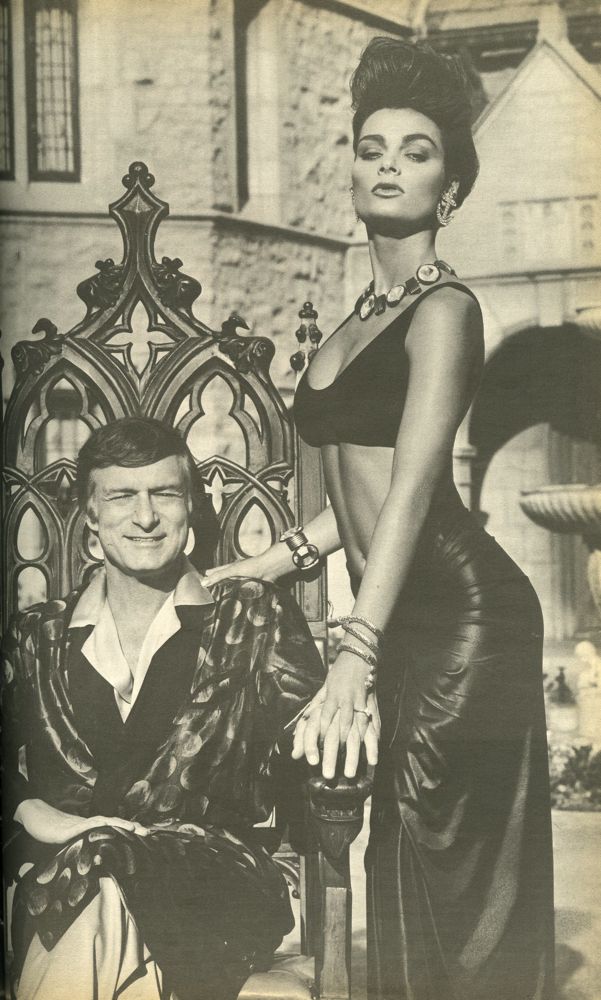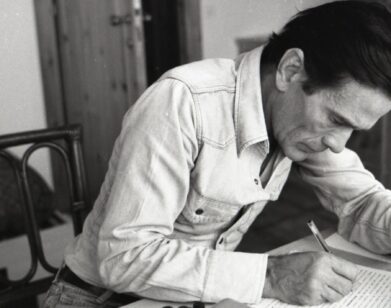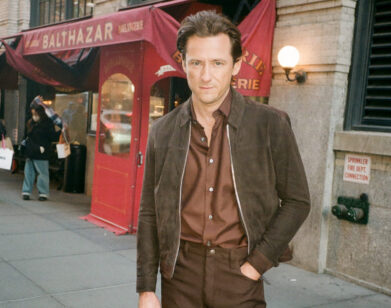New Again: Hugh Hefner

ABOVE: HUGH HEFNER IN AT THE PLAYBOY MANSION, LA IN 1985 WITH HIS THEN-GIRLFRIEND, CARRIE LEIGH.
52 years ago on this leap-year day, the first ever Playboy club opened in Chicago. Three years later, Gloria Steinem went undercover as a Bunny at the Playboy club in New York. In her article I Was a Playboy Bunny, Steinem exposed the unpleasant treatment of Bunnies, which included a demerit system—minus points for a scruffy tail, heels lower than three inches, sneezing and breaking the zipper on a bunny costume, eating in the bunny room, failing to keep a regular makeup appointment, chewing gum while on duty—and obligatory venereal tests. The Chicago playboy club closed in 1986, but as of summer 2011, there are plans to open a new one, presumably with very different guidelines for Bunnies. We interviewed Hugh Hefner, Playboy‘s notorious founder, for our media issue in December in 1985—an issue that also contained a section of interviews with “media Christians” such as Jerry Fallwell. In Hefner’s interview with Interview, reprinted below, he discusses everything from liberation politics to male Bunnies (whatever happened to those?), cocaine, societal norms surrounding sex, the Playboy–Hustler feud, and his close relationship with women, especially former girlfriends. Unfortunately for Hef, this last claim—that he maintains close friendships with his ex-girlfriends—is somewhat ruined when he cannot remember the name of one of the girlfriends in question. Whether you are fascinated, bored, amused or disgusted by him, there is no denying Hefner’s influence on 20th- and 21st-century Western culture, and many of the arguments made against Playboy in the ’60s and ’70s—the place of sexuality in American culture (not so much women’s rights, which is sad)—continue to dominate American political debates.
Media: Rabbit is Rich
by Jonathan Roberts
When one says “His life is his work,” people usually think you mean a man is simply dedicated. When you say it about Hugh Hefner, you mean that his life and his work are inseparable and practically indistinguishable from one another.
Based partly on his own fantasies and aspirations, and partly on a very accurate guess as to the fantasies and aspirations of male America, Hefner founded Playboy magazine—the most famous and often notorious men’s magazine ever anywhere—in 1953. Through the magazine, he promoted his libertarian ideas—particularly in the area of sexual freedom. Because of the magazine’s success at promoting the Playboy lifestyle, Hefner was able to afford a personal lifestyle which grew to resemble the magazine’s more and more in both form and content.
American men felt that they knew Hefner. Hef was their stand-in, their proxy, their alter ego—first in the 48-room Playboy mansion in Chicago and later on in the five-and-a-half-acre Los Angeles estate which replaced it. At the Playboy mansions, the outside world suspected, life must be a constant orgy.
On the Monday afternoon I visited Hefner, there was anything but an orgy going on. The estate was regal, peaceful and immaculate. Flamingos strolled across the lawn of the massive stone manor house. (Hefner has a private zoo as well.) The waterfall was splashing above the pool and the famous private grottoes equipped with full sound systems and huge pillows. The sun danced through the treetops of the largest redwood grove in Southern California. It felt like we were miles—not blocks—from the traffic of Sunset Boulevard’s dreaded Dead Man’s Curve.
Hefner greet me in his traditional working garb—striking silver silk pajamas, velvet slippers and black silk robe. Anyone else might look like an invalid (albeit a very rich one) in such an ensemble in mid-afternoon. But Hugh looked as fit as ever, impressive evidence of his remarkable recovery from a mild stroke that affected the left lobe of his brain. After long digressions, he was able to return to subjects of questions that I had lost track of. His speech has a slight, pleasant slur to it, but then it always did, sounding both authoritative and friendly. Hefner spoke with great enthusiasm about future plans for Playboy Enterprises, Inc., which is now headed by his daughter, Christie. In particular, he was looking forward to the November opening of the new New York Playboy Club which will feature the first male Bunnies.
JONATHAN ROBERTS: I want to open with the same question that the Playmates are asked each month. Name?
HUGH HEFNER: Hugh Hefner.
ROBERTS: Birthplace?
HEFNER: Chicago. My folks were born and raised in Nebraska. Farm people.
ROBERTS: Height?
HEFNER: Just under six feet. About five-ten and a half.
ROBERTS: Weight?
HEFNER: 175.
ROBERTS: Bust, waist and hips?
HEFNER: What sort of bunny would I make?
ROBERTS: Favorite book?
HEFNER: My favorite movie would be very easy to talk about.
ROBERTS: Favorite movie?
HEFNER: The Maltese Falcon. I was probably the first major McLuhanesque editor in that my growing up in the ‘30s and ‘40s was influenced far more by film than by books.
ROBERTS: That’s unusual.
HEFNER: I have always been very visually oriented, which is related to why Playboy has been such a design-related magazine. When Playboy began, commercial magazine illustration was largely in the Norman Rockwell-realistic school. And we changed that into everything from impressionistic to realistic to abstract.
ROBERTS: [I pointed out the portrait of Hefner hanging over the library fireplace, painted in Renaissance style, with intentionally age-crazed paint.] Is this from a magazine illustration?
HEFNER: No. It was a gift from a friend. It’s quite literally a photograph that was changed into a Renaissance print.
ROBERTS: I was born in 1954, about the same time as the magazine. So Playboy has been exerting its influence on my whole generation of men. But, there seem to be fewer tit men in my generation. If you ask anyone my age, nobody will admit to being into breasts. But in Playboy we still see great bosoms. Do you ever worry that things are changing, and the image of the Playmate, the Bunny, isn’t keeping up?
HEFNER: Obviously, an awful lot of my own particular perceptions come from early periods. The original concept of women that was projected in the magazine is what has become known as a “healthy kind of outdoor California look.” What Playboy is really projecting is that kind of co-ed. Cheerleader, girl-next-door look. And when Playboy began, we were working against what the women’s fashion magazines were doing. What they were into was an almost antisexual kind of thing. The skirt down almost to the ankles. Also, it was a corseted look. Even young women wore girdles, and bras that made the breasts very unnatural.
ROBERTS: You can’t have a corseted look on a nude woman.
HEFNER: It’s more than that. It is much more of an outdoor, tan look.
ROBERTS: Here’s a quote from Bob Guccione [editor and publisher of Penthouse magazine]. He said that at Penthouse, “There has never been a fetish as far as big breasts are concerned. It was always the overall appeal of the girl. Particularly, her face or expression. We never airbrush the pictures. We let the moles and scars show…”
HEFNER: Through soft-focus gels.
ROBERTS: Guccione said, “That’s what makes a real Penthouse girl. Playboy never understood that. They change the shape of a girl’s breast.”
HEFNER: The truth of the matter is that Penthouse is rooted much more in Victorian pornography. It is much more European. It’s more soft-focus, fantasy kind of orientation, and the text that accompanies the material has nothing to do with the real lives of the women. They’re a sex fantasy magazine. What we try and do is associate sex with everyday life. We make the women—in a limited way, obviously—accessible. Saying in effect: Your girlfriend is not so different from our Playmate. She is the girl next door.
Now there is the impression that Playboy has had a fetish with breasts. To whatever extent that is in any way true, it is a reflection of the society and the fetishes that existed in the period in which the magazine existed. If either magazine had a fetish, I would say it was Penthouse and their fetish is clearly gynecological.
ROBERTS: Do you ever feel threatened by the fact that they seem to be going a step further?
HEFNER: In the early ’70s we overreacted briefly. We started to make the magazine much more sexually explicit. And, in effect, started imitating the imitator. I called a halt to it, and since that time we have chosen our own particular route, and I think we’re doing far better. Penthouse is no sense was the most explicit publication out there. As a matter of fact, if you look at the magazine from the ‘50s and the early ’60s, most of the material that caused the excitement in those days could appear on TV today. You know, our society has had such a hang-up about the human body and about sexuality that what I attempted to do was give sex a good name. I attempted to associate things erotic and the human female form with everyday life, with the good life. The conflict was when I was growing up and when Playboy began was a puritan notion of conflict between the body and mind of a man. Which is a constant puritan hang-up. Now, in 1985, largely because of the fundamentalist religious thing that is going on, but partly because of a small faction of the feminist movement, there is a very anti-sexual kind of position.
ROBERTS: You mean the Women Against Pornography movement?
HEFNER: Yes, yes. And the anti-porn movement has turned into a fascist movement that is now reflected in—this comes more from the religious fundamentalists—the federal government. You’ve got a sexual McCarthyism going on right now with statements from the Surgeon General and the Justice Department and this Mickey Mouse committee they’re sending around the country supposedly exploring the meaning of pornography, but ignoring all the actual facts. What they’re actually doing is inflaming people. It’s now starting to include rock ‘n’ roll. The more things change, the more they stay the same. When the subject is sex, it’s actually unbelievable. All the hang-ups are being reintroduced, and the sadness is that with the combination of AIDS and the fear that we are back in a time in which sex is being associated with sin, disease, it’s like it’s not grown-up.
ROBERTS: Guccione said at one point, “When our industry was threatened and we wanted to bring people together so that we could fight as one, he [Hefner] was the one who did not want to become involved.” Do you feel that you’ve lived up to a commitment to protect the freedoms that you’ve–
HEFNER: Yes. I have very much tried to protect the freedoms. It isn’t just a matter of editorially supporting these notions. We have financed sexual research for Masters and Johnson, the Kinsey Institute—I mean that goes back to the early ’60s. To the hurtful laws relating to marijuana, the founding of NORML, we supplied the money for that. To the changing of abortion laws, the changing of sexuality before the women’s movement even existed.
ROBERTS: There seem to be a lot of misconceptions.
HEFNER: There are so many misconceptions relating to Playboy and myself that one hardly knows where to begin. With this anti-sex attitude… which has finally focused on the anti-porn position, not only is nudity thought of as exploitation, but pornography, explicit sexual images, are thought of as the equivalent of literary rape. If one takes those kinds of attitudes toward the human body and towards sexuality, where does it take you? If explicit sexual images are hurtful or demeaning to the female sex, what does that say about sex?
ROBERTS: Do you identify with liberation politics?
HEFNER: Yeah, sure, absolutely.
ROBERTS: With all the publicity on cocaine… seeing the downside of it?
HEFNER: I’ve hated cocaine from the very outset. I’ve seen cocaine as a very, very hurtful drug. It changes people’s personalities. It is one of the most habit-forming drugs and I’ve seen it seriously hurt the lives of a number of friends.
ROBERTS: Drinking and smoking are just as dangerous.
HEFNER: What I have to say about alcohol and tobacco is that it kills people.
ROBERTS: Why advertise it, then? Why carry cigarette and liquor ads?
HEFNER: What we try to do is communicate information and popularize a lifestyle that permits people to make choices. I smoked a pipe myself without inhaling until I had the stroke in March. And I don’t smoke now. We all have a tendency to not deal with our own mortality. And sometimes it takes a tap on the shoulder.
ROBERTS: What do you want people to know about you?
HEFNER: What is Hugh Hefner really like? A very sensitive, gentile, caring guy with a great deal of insight in terms of his own life and in terms of the world around him, with a rich sense of humor. I’m a very loving person. A person who has very long-term, close friendships and romantic relationships. I remain close to the major women in my life. Close in terms of friendships.
ROBERTS: Close?
HEFNER: Gay Talese was visiting here a few months after the book, Thy Neighbor’s Wife, was out [which included several chapters about Hefner], and two of the women who were in the book, former girlfriends of mine, were here that Sunday.
ROBERTS: Who?
HEFNER: Karen Christy from Texas, and… I can’t remember who the other one was. I said, “It’s strange, Gay, because it the book it sounds like, at the end of these relationships, the women leave either miffed or glad to be gone. Both of these women care a great deal about me, but they’re very pissed at you, Gay.” [laughs]
ROBERTS: How many people live here at the “Mansion”?
HEFNER: The only other person who lives here full time is my girlfriend. There’s a guest house and a number of guest rooms. Richard Brooks [the director] was staying with me for a while when his house was being built—three or four months. Tony Curtis was staying here a short time ago. The guest house is used for Playmates or models we’re testing. We had a whole bunch of them here this past weekend because we shot a video called The Playmate Playoffs.
ROBERTS: You feel very comfortable mixing business with pleasure?
HEFNER: Like you say, this is the classic greatest tax deduction. Where else can you make a legitimate case where a private home works as a promotional extension of your business?
ROBERTS: Guccione said, “I’m very careful about whom I let into the house. I’m guarded against my house being a funpark on the order of the Playboy Mansion.”
HEFNER: In other words, his house is not a fun place, huh? One of my problems, incidentally, was the popularity… of first Penthouse and then Hustler—up until that point Playboy was very accurately perceived as a more sexually sophisticated, quality magazine. There were lots and lots of imitations of Playboy, but they were thought of as really girlie magazines and Playboy was always something apart. When Penthouse closed the hap and then Hustler followed it, we were thought of, from that point on, as the class end of another field. And the difference between the magazine is not just style and content.
ROBERTS: By putting quality with sexuality you are legitimizing sexuality. Gay Talese takes it one step further and says, basically, that you took masturbation out of the closet.
HEFNER: I think one of the original projections in Gay’s book is his own hang-up relating to his fascination with masturbation. The major initial repression which exists in terms of puritan repression is masturbation. It begins in the crib when the mother lets the baby know it is perfectly okay to touch himself—except there. To whatever extent it is, it improves the quality of masturbation. Not the masturbation, but the fantasies that go with it. The truth of the matter is that there has always been much more explicit, more masturbatory material available, always, since the early days of Playboy. I think what we legitimized were fantasies. If you want to call them masturbatory fantasies, fine. I think that there’s nothing wrong with masturbation. If you’re not feeling good about your own sexuality and your own body, you’re not going to feel good about anything else.
ROBERTS: Is your life here the way everyone imagines it? What is your day like?
HEFNER: My day begins at noon. My first meeting is at two in the afternoon. I spend an hour with my office staff before that. The evenings are usually spent in relaxation and play—games, movies, hanging out with friends.
ROBERTS: How often do you leave here?
HEFNER: I don’t get out a great deal. It’s not as isolated as it all seems. In the ’60s [in Chicago] it was all indoors and I not only controlled the seasons but the time of day. Here it’s an indoor-outdoor life. It appears that we’re in the middle of a European country, but I’m a block from Sunset Boulevard in the middle of a major city. It has been referred to as Shangri-La.
ROBERTS: I want to know a little about your girlfriend.
HEFNER: Carrie and I have a relationship that began about two-and-a-half years ago. She had done a cover for us. She was a model from Canada and she was here testing for Playmate. I had been in a relationship with Shannon Tweed for about two years, and that relationship had ended a few months before. I had really intended not to get seriously involved with someone for a while. But… I am a very romantic guy and I do tend to—with all the fun and games that go on—get emotionally involved in an ongoing relationship. That has not always been the case. I’m very happy with my present relationship.
ROBERTS: Do you think each relationship will go on forever?
HEFNER: No. Nothing goes on forever. I think that’s one of the illusions of life. When I talk about my life being an extension of my dreams and fantasies, there’s a tendency to think of them as immature. I live in a mature world. The majority of the people in this society live with delusions and illusions much more irrational and hurtful than mine. They deal with mortality, with fantasies relating to heaven and hell, and they don’t really deal with their problems at all. I’m dealing with the same bittersweet realities of life that we all have to deal with..
ROBERTS: And—
HEFNER: I mean, life is bittersweet. Inside our heads, if we’re lucky, we’re the same kids as we were when we were young.
For more New Again click here.






